Strategic Human Resource Management Report: Personal Reflections
VerifiedAdded on 2022/07/28
|5
|1384
|47
Report
AI Summary
This report analyzes strategic human resource management through five exercises. The first exercise explores the author's personal experiences and how societal expectations shaped their understanding of masculinity. The second exercise details an arresting moment involving racial profiling in a hospital setting, highlighting issues of racism and privilege in Australia. The third exercise examines stereotypes about the author's nationality and their experience with racial tension during a visit to an Aboriginal community. The fourth exercise presents an ethical dilemma involving workplace relationships and the application of ethical decision-making models. The fifth exercise explores the sociological construction of an ideal worker and the concept of "strange in the familiar," reflecting on racial biases and societal norms. The report provides insights into leadership, ethics, and cultural understanding within a human resource context.
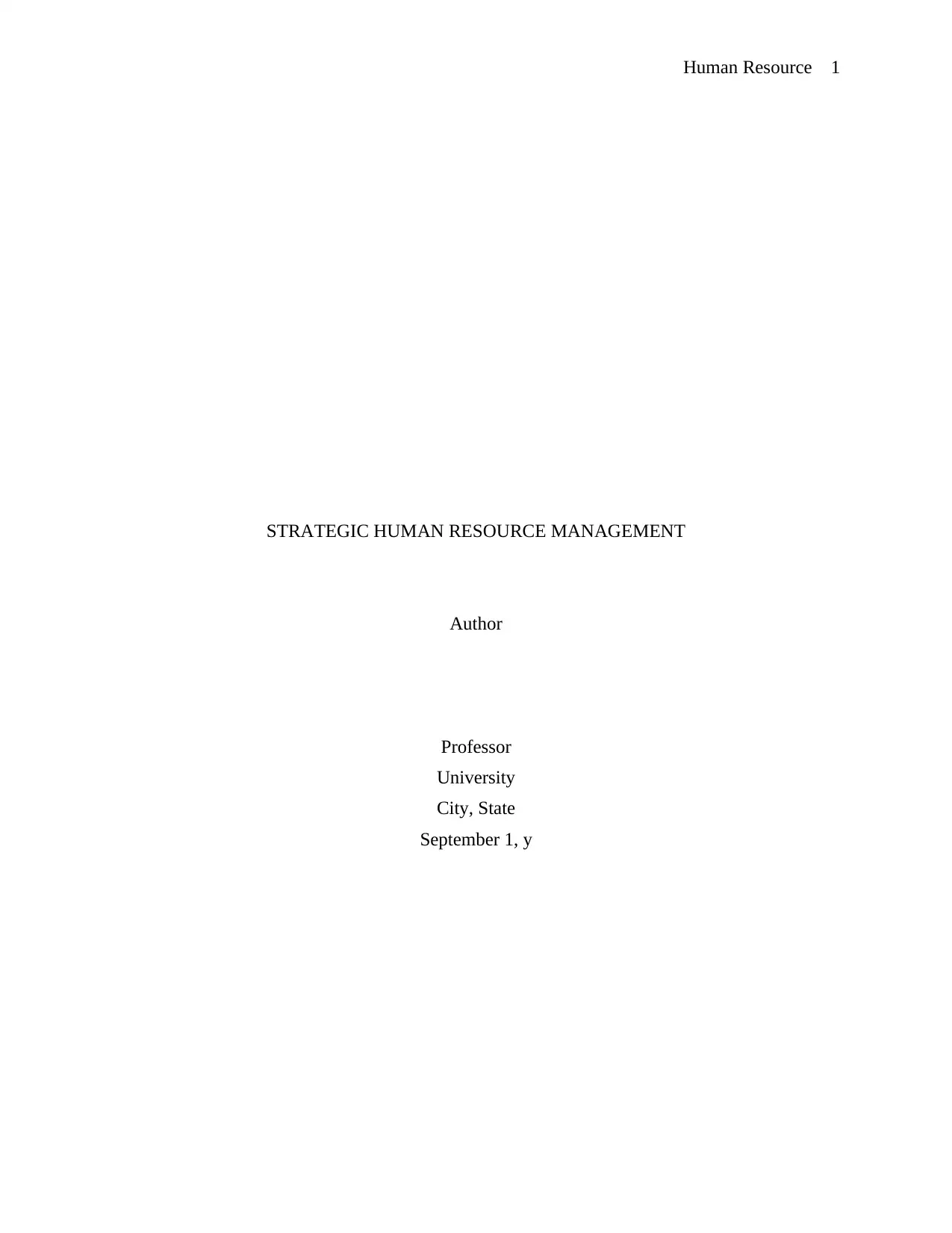
Human Resource 1
STRATEGIC HUMAN RESOURCE MANAGEMENT
Author
Professor
University
City, State
September 1, y
STRATEGIC HUMAN RESOURCE MANAGEMENT
Author
Professor
University
City, State
September 1, y
Paraphrase This Document
Need a fresh take? Get an instant paraphrase of this document with our AI Paraphraser
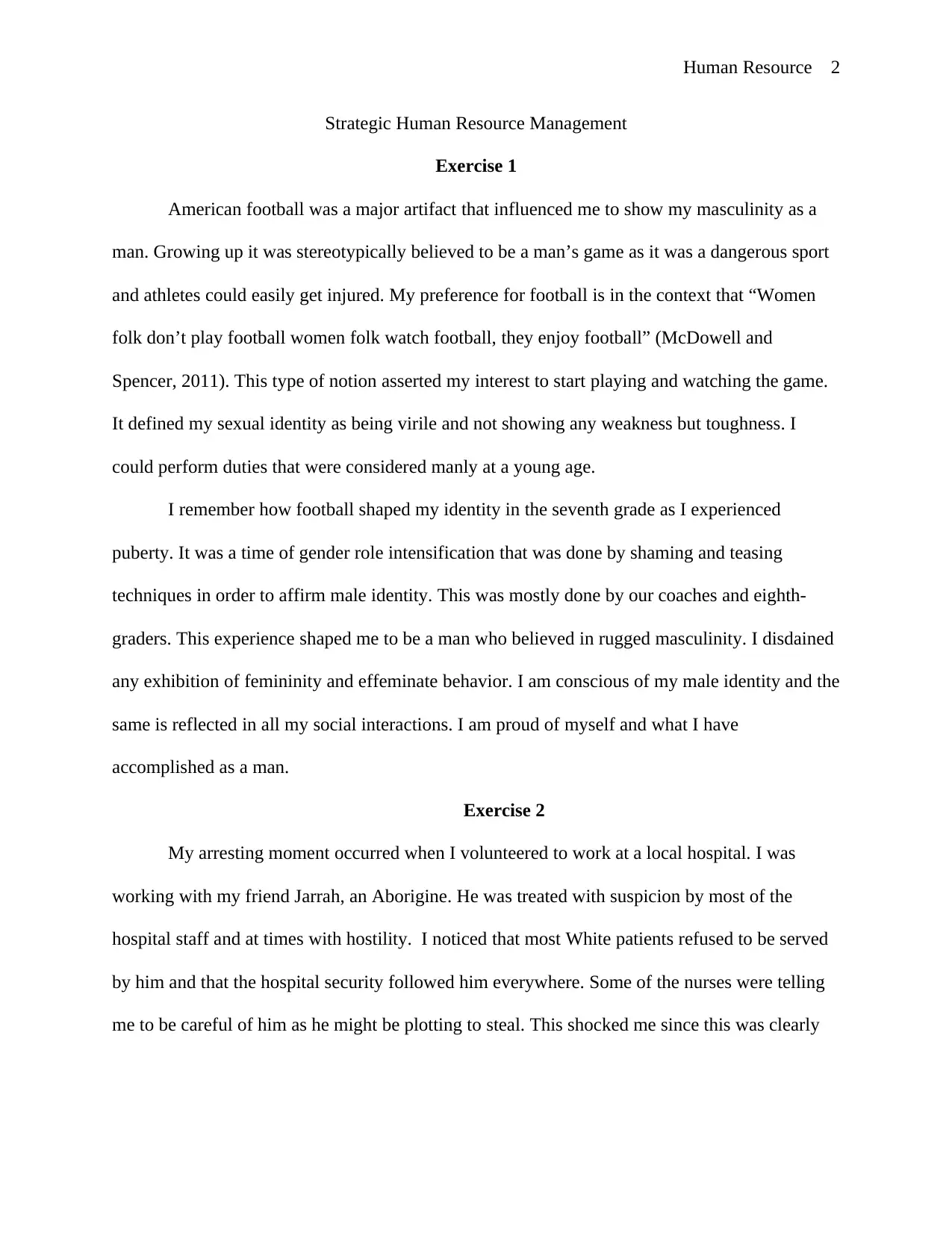
Human Resource 2
Strategic Human Resource Management
Exercise 1
American football was a major artifact that influenced me to show my masculinity as a
man. Growing up it was stereotypically believed to be a man’s game as it was a dangerous sport
and athletes could easily get injured. My preference for football is in the context that “Women
folk don’t play football women folk watch football, they enjoy football” (McDowell and
Spencer, 2011). This type of notion asserted my interest to start playing and watching the game.
It defined my sexual identity as being virile and not showing any weakness but toughness. I
could perform duties that were considered manly at a young age.
I remember how football shaped my identity in the seventh grade as I experienced
puberty. It was a time of gender role intensification that was done by shaming and teasing
techniques in order to affirm male identity. This was mostly done by our coaches and eighth-
graders. This experience shaped me to be a man who believed in rugged masculinity. I disdained
any exhibition of femininity and effeminate behavior. I am conscious of my male identity and the
same is reflected in all my social interactions. I am proud of myself and what I have
accomplished as a man.
Exercise 2
My arresting moment occurred when I volunteered to work at a local hospital. I was
working with my friend Jarrah, an Aborigine. He was treated with suspicion by most of the
hospital staff and at times with hostility. I noticed that most White patients refused to be served
by him and that the hospital security followed him everywhere. Some of the nurses were telling
me to be careful of him as he might be plotting to steal. This shocked me since this was clearly
Strategic Human Resource Management
Exercise 1
American football was a major artifact that influenced me to show my masculinity as a
man. Growing up it was stereotypically believed to be a man’s game as it was a dangerous sport
and athletes could easily get injured. My preference for football is in the context that “Women
folk don’t play football women folk watch football, they enjoy football” (McDowell and
Spencer, 2011). This type of notion asserted my interest to start playing and watching the game.
It defined my sexual identity as being virile and not showing any weakness but toughness. I
could perform duties that were considered manly at a young age.
I remember how football shaped my identity in the seventh grade as I experienced
puberty. It was a time of gender role intensification that was done by shaming and teasing
techniques in order to affirm male identity. This was mostly done by our coaches and eighth-
graders. This experience shaped me to be a man who believed in rugged masculinity. I disdained
any exhibition of femininity and effeminate behavior. I am conscious of my male identity and the
same is reflected in all my social interactions. I am proud of myself and what I have
accomplished as a man.
Exercise 2
My arresting moment occurred when I volunteered to work at a local hospital. I was
working with my friend Jarrah, an Aborigine. He was treated with suspicion by most of the
hospital staff and at times with hostility. I noticed that most White patients refused to be served
by him and that the hospital security followed him everywhere. Some of the nurses were telling
me to be careful of him as he might be plotting to steal. This shocked me since this was clearly
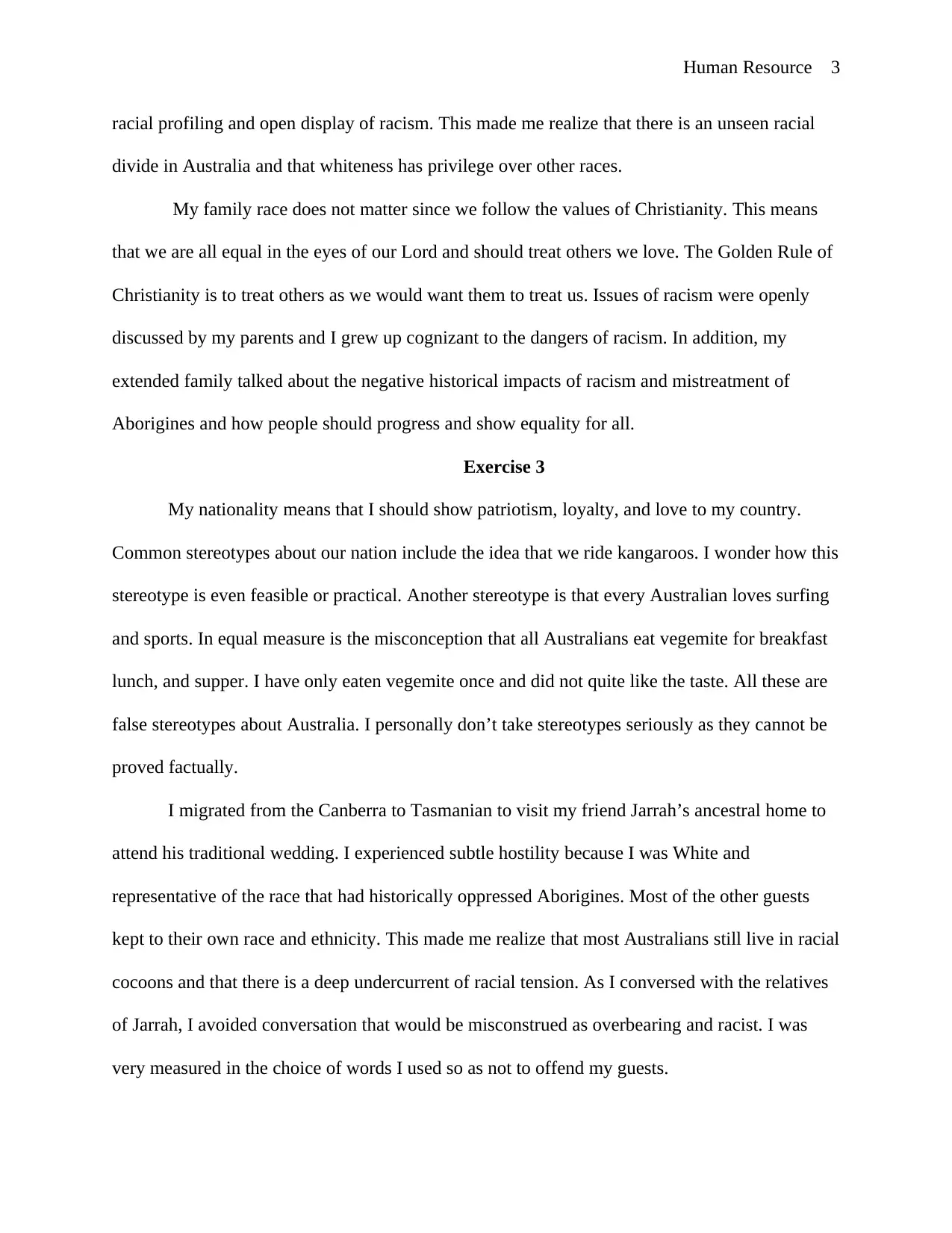
Human Resource 3
racial profiling and open display of racism. This made me realize that there is an unseen racial
divide in Australia and that whiteness has privilege over other races.
My family race does not matter since we follow the values of Christianity. This means
that we are all equal in the eyes of our Lord and should treat others we love. The Golden Rule of
Christianity is to treat others as we would want them to treat us. Issues of racism were openly
discussed by my parents and I grew up cognizant to the dangers of racism. In addition, my
extended family talked about the negative historical impacts of racism and mistreatment of
Aborigines and how people should progress and show equality for all.
Exercise 3
My nationality means that I should show patriotism, loyalty, and love to my country.
Common stereotypes about our nation include the idea that we ride kangaroos. I wonder how this
stereotype is even feasible or practical. Another stereotype is that every Australian loves surfing
and sports. In equal measure is the misconception that all Australians eat vegemite for breakfast
lunch, and supper. I have only eaten vegemite once and did not quite like the taste. All these are
false stereotypes about Australia. I personally don’t take stereotypes seriously as they cannot be
proved factually.
I migrated from the Canberra to Tasmanian to visit my friend Jarrah’s ancestral home to
attend his traditional wedding. I experienced subtle hostility because I was White and
representative of the race that had historically oppressed Aborigines. Most of the other guests
kept to their own race and ethnicity. This made me realize that most Australians still live in racial
cocoons and that there is a deep undercurrent of racial tension. As I conversed with the relatives
of Jarrah, I avoided conversation that would be misconstrued as overbearing and racist. I was
very measured in the choice of words I used so as not to offend my guests.
racial profiling and open display of racism. This made me realize that there is an unseen racial
divide in Australia and that whiteness has privilege over other races.
My family race does not matter since we follow the values of Christianity. This means
that we are all equal in the eyes of our Lord and should treat others we love. The Golden Rule of
Christianity is to treat others as we would want them to treat us. Issues of racism were openly
discussed by my parents and I grew up cognizant to the dangers of racism. In addition, my
extended family talked about the negative historical impacts of racism and mistreatment of
Aborigines and how people should progress and show equality for all.
Exercise 3
My nationality means that I should show patriotism, loyalty, and love to my country.
Common stereotypes about our nation include the idea that we ride kangaroos. I wonder how this
stereotype is even feasible or practical. Another stereotype is that every Australian loves surfing
and sports. In equal measure is the misconception that all Australians eat vegemite for breakfast
lunch, and supper. I have only eaten vegemite once and did not quite like the taste. All these are
false stereotypes about Australia. I personally don’t take stereotypes seriously as they cannot be
proved factually.
I migrated from the Canberra to Tasmanian to visit my friend Jarrah’s ancestral home to
attend his traditional wedding. I experienced subtle hostility because I was White and
representative of the race that had historically oppressed Aborigines. Most of the other guests
kept to their own race and ethnicity. This made me realize that most Australians still live in racial
cocoons and that there is a deep undercurrent of racial tension. As I conversed with the relatives
of Jarrah, I avoided conversation that would be misconstrued as overbearing and racist. I was
very measured in the choice of words I used so as not to offend my guests.
⊘ This is a preview!⊘
Do you want full access?
Subscribe today to unlock all pages.

Trusted by 1+ million students worldwide
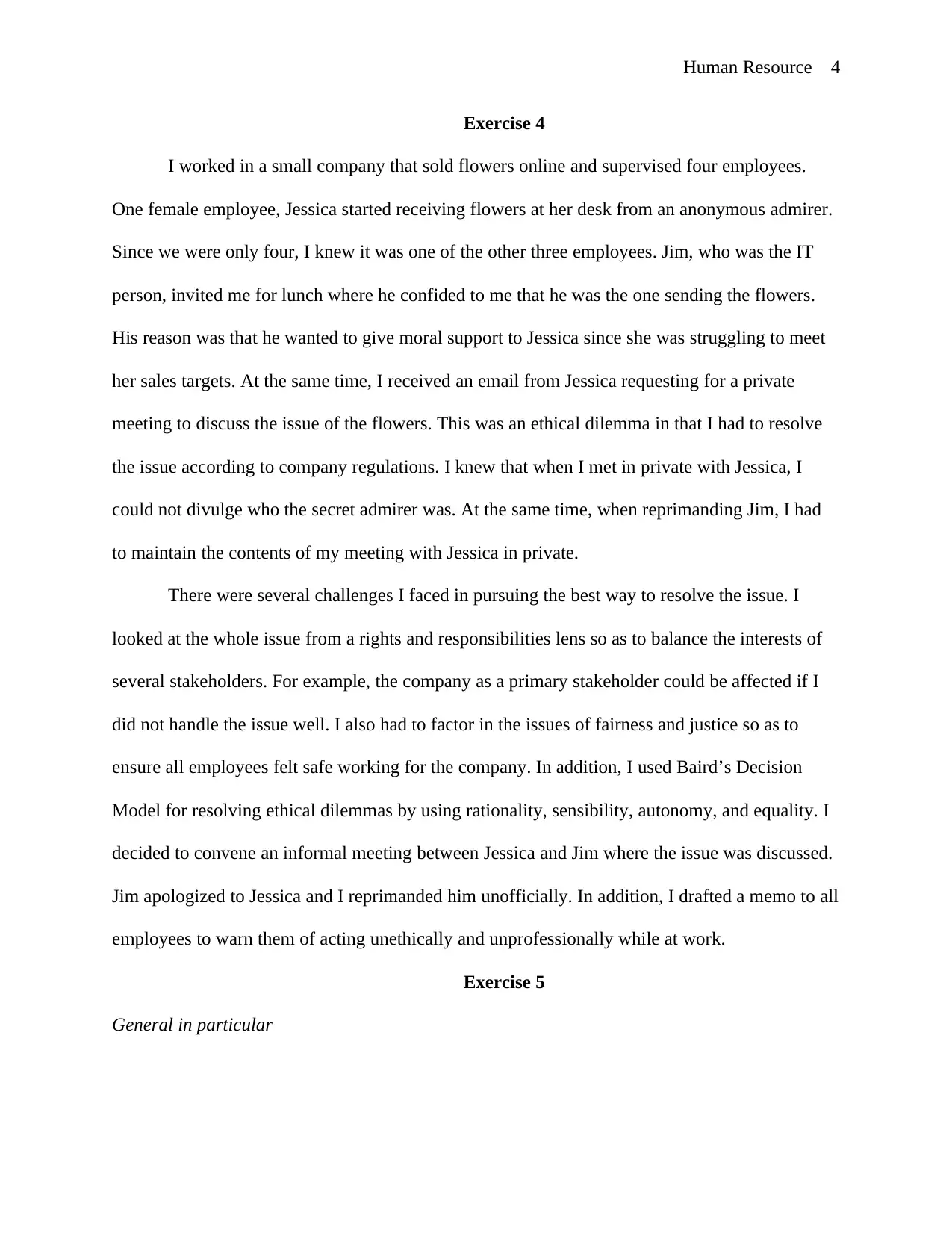
Human Resource 4
Exercise 4
I worked in a small company that sold flowers online and supervised four employees.
One female employee, Jessica started receiving flowers at her desk from an anonymous admirer.
Since we were only four, I knew it was one of the other three employees. Jim, who was the IT
person, invited me for lunch where he confided to me that he was the one sending the flowers.
His reason was that he wanted to give moral support to Jessica since she was struggling to meet
her sales targets. At the same time, I received an email from Jessica requesting for a private
meeting to discuss the issue of the flowers. This was an ethical dilemma in that I had to resolve
the issue according to company regulations. I knew that when I met in private with Jessica, I
could not divulge who the secret admirer was. At the same time, when reprimanding Jim, I had
to maintain the contents of my meeting with Jessica in private.
There were several challenges I faced in pursuing the best way to resolve the issue. I
looked at the whole issue from a rights and responsibilities lens so as to balance the interests of
several stakeholders. For example, the company as a primary stakeholder could be affected if I
did not handle the issue well. I also had to factor in the issues of fairness and justice so as to
ensure all employees felt safe working for the company. In addition, I used Baird’s Decision
Model for resolving ethical dilemmas by using rationality, sensibility, autonomy, and equality. I
decided to convene an informal meeting between Jessica and Jim where the issue was discussed.
Jim apologized to Jessica and I reprimanded him unofficially. In addition, I drafted a memo to all
employees to warn them of acting unethically and unprofessionally while at work.
Exercise 5
General in particular
Exercise 4
I worked in a small company that sold flowers online and supervised four employees.
One female employee, Jessica started receiving flowers at her desk from an anonymous admirer.
Since we were only four, I knew it was one of the other three employees. Jim, who was the IT
person, invited me for lunch where he confided to me that he was the one sending the flowers.
His reason was that he wanted to give moral support to Jessica since she was struggling to meet
her sales targets. At the same time, I received an email from Jessica requesting for a private
meeting to discuss the issue of the flowers. This was an ethical dilemma in that I had to resolve
the issue according to company regulations. I knew that when I met in private with Jessica, I
could not divulge who the secret admirer was. At the same time, when reprimanding Jim, I had
to maintain the contents of my meeting with Jessica in private.
There were several challenges I faced in pursuing the best way to resolve the issue. I
looked at the whole issue from a rights and responsibilities lens so as to balance the interests of
several stakeholders. For example, the company as a primary stakeholder could be affected if I
did not handle the issue well. I also had to factor in the issues of fairness and justice so as to
ensure all employees felt safe working for the company. In addition, I used Baird’s Decision
Model for resolving ethical dilemmas by using rationality, sensibility, autonomy, and equality. I
decided to convene an informal meeting between Jessica and Jim where the issue was discussed.
Jim apologized to Jessica and I reprimanded him unofficially. In addition, I drafted a memo to all
employees to warn them of acting unethically and unprofessionally while at work.
Exercise 5
General in particular
Paraphrase This Document
Need a fresh take? Get an instant paraphrase of this document with our AI Paraphraser
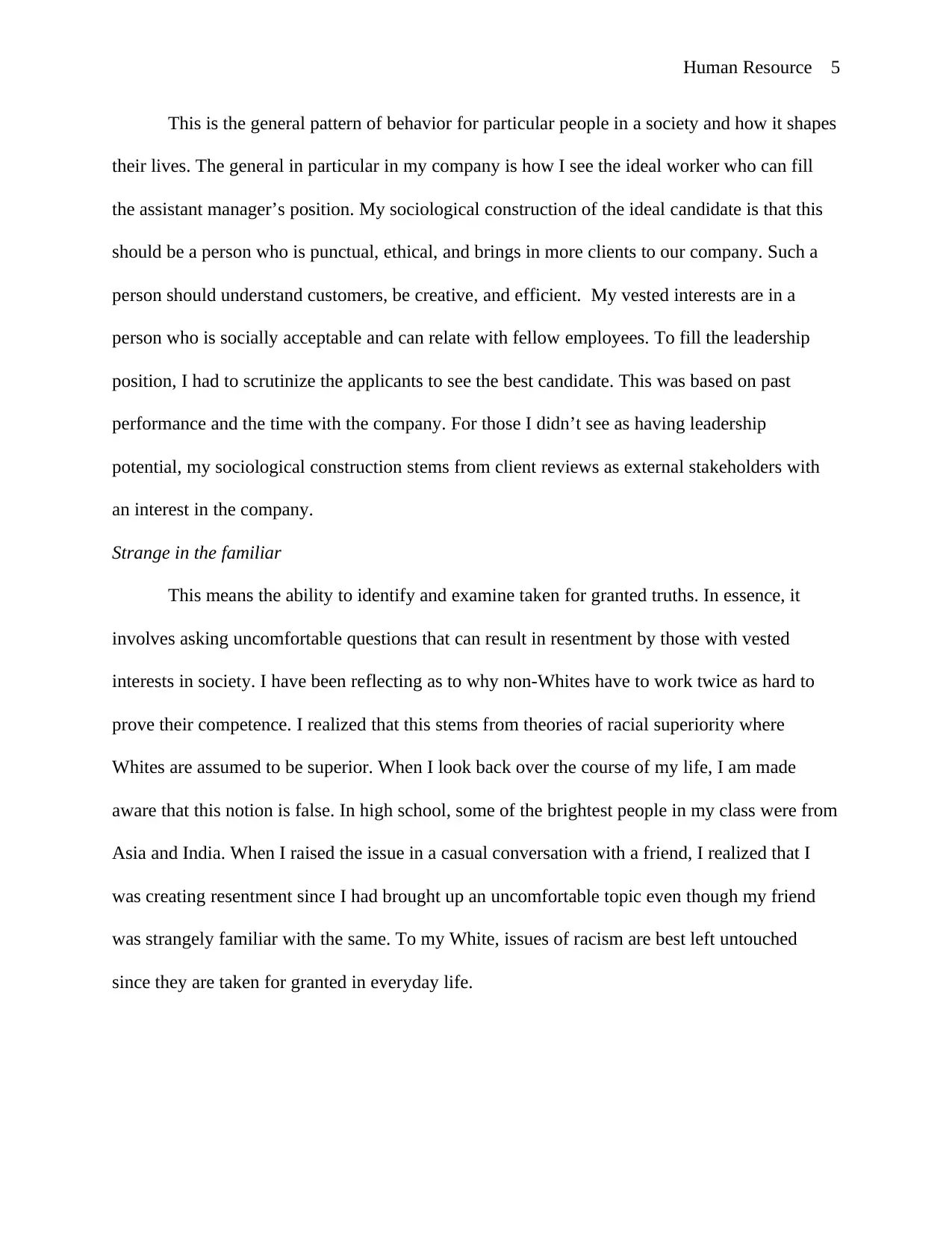
Human Resource 5
This is the general pattern of behavior for particular people in a society and how it shapes
their lives. The general in particular in my company is how I see the ideal worker who can fill
the assistant manager’s position. My sociological construction of the ideal candidate is that this
should be a person who is punctual, ethical, and brings in more clients to our company. Such a
person should understand customers, be creative, and efficient. My vested interests are in a
person who is socially acceptable and can relate with fellow employees. To fill the leadership
position, I had to scrutinize the applicants to see the best candidate. This was based on past
performance and the time with the company. For those I didn’t see as having leadership
potential, my sociological construction stems from client reviews as external stakeholders with
an interest in the company.
Strange in the familiar
This means the ability to identify and examine taken for granted truths. In essence, it
involves asking uncomfortable questions that can result in resentment by those with vested
interests in society. I have been reflecting as to why non-Whites have to work twice as hard to
prove their competence. I realized that this stems from theories of racial superiority where
Whites are assumed to be superior. When I look back over the course of my life, I am made
aware that this notion is false. In high school, some of the brightest people in my class were from
Asia and India. When I raised the issue in a casual conversation with a friend, I realized that I
was creating resentment since I had brought up an uncomfortable topic even though my friend
was strangely familiar with the same. To my White, issues of racism are best left untouched
since they are taken for granted in everyday life.
This is the general pattern of behavior for particular people in a society and how it shapes
their lives. The general in particular in my company is how I see the ideal worker who can fill
the assistant manager’s position. My sociological construction of the ideal candidate is that this
should be a person who is punctual, ethical, and brings in more clients to our company. Such a
person should understand customers, be creative, and efficient. My vested interests are in a
person who is socially acceptable and can relate with fellow employees. To fill the leadership
position, I had to scrutinize the applicants to see the best candidate. This was based on past
performance and the time with the company. For those I didn’t see as having leadership
potential, my sociological construction stems from client reviews as external stakeholders with
an interest in the company.
Strange in the familiar
This means the ability to identify and examine taken for granted truths. In essence, it
involves asking uncomfortable questions that can result in resentment by those with vested
interests in society. I have been reflecting as to why non-Whites have to work twice as hard to
prove their competence. I realized that this stems from theories of racial superiority where
Whites are assumed to be superior. When I look back over the course of my life, I am made
aware that this notion is false. In high school, some of the brightest people in my class were from
Asia and India. When I raised the issue in a casual conversation with a friend, I realized that I
was creating resentment since I had brought up an uncomfortable topic even though my friend
was strangely familiar with the same. To my White, issues of racism are best left untouched
since they are taken for granted in everyday life.
1 out of 5
Your All-in-One AI-Powered Toolkit for Academic Success.
+13062052269
info@desklib.com
Available 24*7 on WhatsApp / Email
![[object Object]](/_next/static/media/star-bottom.7253800d.svg)
Unlock your academic potential
Copyright © 2020–2025 A2Z Services. All Rights Reserved. Developed and managed by ZUCOL.

